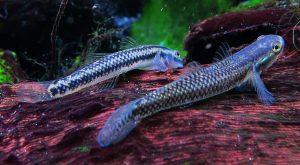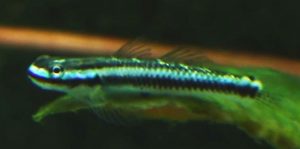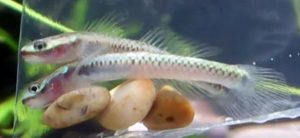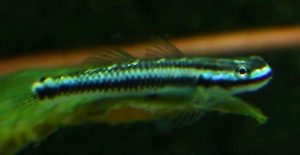The Cobalt Blue Goby (Stiphodon semoni) considered by many tropical fish keeping enthusiasts to be one of the most colorful freshwater gobies in the genus Stiphodon, is found in West Papua, Indonesia.
It range extends from Ambon Island chain, South Molucca Islands, east from western Sumatra across most of Indonesia, Northern Papua New Guinea, and as far as the Solomon Islands in the Bismarck Archipelago.
Although Cobalt Blue Gobies are similar in appearance to Stiphodon atropurpureus that is found outside their range in the Phillipines, they may coexist with less similar Stiphodon carisa in Sumatra, and Stiphodon atratus found from Halmahera to Papua New Guinea.
Cobalt Blue Gobies have fused pelvic fins that form a “pelvic disc” which is a common characteristic among gobiids that allows them to cling to rocks and other submerged surfaces. The pelvic disc enables them to hold onto submerged rocks while feeding, move along the bottom against very strong currents, and to actually climb up waterfalls and fast flowing cascades. This trait has given them the generic name of “rock climbing” or “clinging” gobies.
Because Cobalt Blue Gobies have replaceable, outwardly oriented teeth in their upper jaw, many tropical fish keeping enthusiasts also refer to them as “toothed lipped” gobies.
Cobalt Blue Gobies have a light gray brown body with an almost electric blue to blue/green lateral stripe that can become almost white in dominant or breeding males. Depending on the velocity of the water where they are collected, all males have a tall, extended dorsal fin of varying height. The males with “taller” first dorsal fins with one or more extended rays tend to live in slower moving streams and do not climb waterfalls as part of their life cycle.
Female Cobalt Blue Gobies have a much lighter body color, shorter first dorsal fins, and possess less colorful zig zag like lateral stripes along their body.
Stiphodon semoni are typically found at higher altitudes in narrow, rapid flowing runs and riffles that are broken up by wide, slower moving stretches that are usually located above the waterfalls or cataracts.
Cobalt Blue Gobies are almost always exclusive inhabitants of the short, coastal streams that are found on these tropical volcanic islands, and reside virtually free of predators above and below the cataracts and waterfalls.
Except for shrimp, neritid snails, other Stiphodon species, and gobies from the genus Sicyopus, their habitat makes them inaccessible to the majority of predatory fish species.
Stiphodon semoni are minimally territorial and generally peaceful in the wild as well as in an aquarium environment.
In their natural habitat, Cobalt Blue Gobies live in small groups where they stake out individual territories to feed on algae and bio films attached to the submerged rocks in the clean, clear, highly oxygenated water.
A pair or small group of Cobalt Blue Gobies are best kept in a biotope stream setting in an “aged” aquarium of at least 15 gallon capacity, with a substrate of varying size gravel and larger river rocks over a sandy base, with a piece or two of well aged driftwood and some leaf litter. Males in particular like to burrow into the substrate when sleeping and spawning, so make sure there are plenty of different sized rocks scattered on the bottom and that the larger rocks sit on the base of the aquarium and not directly on the sand.
Aquatic plants are not necessary or present in their natural environment, but hardier species such as Anubias, Crinum, and Microsorum
can be used in the tank for aesthetics.
Although Cobalt Blue Gobies do not necessarily need torrential water conditions, they do require a lot of water movement and extremely pristine water. An oversize water filtration system with at least one powerhead is recommended to provide a turnover of at least 5 to 10 times/hr. of tank volume, but 10 to 15 times/hr. of tank volume per hour is much preferred.
Although weekly 30 to 50% water changes are also needed, the rest of the tank doesn’t have to be “spotless”. Allow green algae to grow on all surfaces except for the front of the tank viewing area. Provide enough bright lighting to promote the growth of algae and other biofilm microorganisms. Some tropical fish keeping enthusiasts “seed” their aquariums with a few pieces of river rock from a clean local stream to get things going.
The key for long term success in keeping this species is to provide them with a mature aquarium and a steady supply of algae covered rocks.
Lastly, because thse fish are climbers, a tightly fitting aquarium cover is highly recommended.
Although Cobalt Blue Gobies tend to be somewhat territorial, especially during the June to November breeding season, several can be housed together in a large “mountain stream” type community aquarium with other gobies such as Sicyopus, Sicyopterus, Rhinogobius, or Schismatogobius spp. provided the tank is large enough, there are plenty of rocky hiding places, and a steady supply of food is available.
A single male with two or more females is recommended.
Other peaceful, similarly sized species that live in well oxygenated streams such as Tanichthys, Microdevario, smaller Danio species, small characids, small poeciliid livebearers, loaches such as Gastromyzon, Pseudogastromyzon, Barbucca, or Acanthopsoides, and freshwater genera Caridina and Neocaridina shrimp can also make good tank mates.
Because of their complex, amphidromous breeding activity, the Cobalt Blue Goby (Stiphodon semoni) has not yet been bred in an aquarium environment.
In their natural habitat, adults live and spawn in the freshwater mountain streams, but the hatched larvae are swept downstream to the ocean where the fry spend the first part of their life cycle plankton developing into adults.
At some point in their development, they begin to migrate upstream and like salmon endure sometimes spectacular climbs over waterfalls and other obstacles to get to their hatching grounds.
During courting, the intensely colored males can be seen trying to coax the females into the spawning site, which is usually under the rocks. During courtship, the males dive head first into the substrate followed by the female where spawning occurs.
Despite their small size, female Cobalt Blue Gobies can deposit as many as 10,000 tiny eggs per spawn. The pear shaped eggs, approximately .5 mm in diameter, are attached to the underside of rocks in the substrate and held fast by filaments.
The male guards the fertilized eggs until hatching occurs, usually within 24 hours. The tiny undeveloped fry have a yolk sac but no mouth, anus, or eyes. The yolk sac is absorbed in 3 or 4 days during which time the fry are dispersed downstream from their steep freshwater hatching stream to the sea. They must reach the sea before their egg sacs are totally absorbed in order to survive on the microscopic plankton.
The larvae remain in pelagic form among the ocean plankton for 78 to 146 days or longer and eventually settle on the substrate in the shallow surf zone where they remain until they lose their temporary emerging caudal fin and begin the long journey back upstream to join the adults. They often travel several miles inland through stretches of fast flowing water over cascades and waterfalls to reach their spawning grounds which can take several months to finish.
Cobalt Blue Gobies are sexually mature in about one year, and since they only live about two years, they initiate spawning almost immediately upon reaching their spawning grounds.
Amphidromy is not unique to members of Stiphodon and is practiced by all other genera.
Stiphodon semoni feed on algae and biofilms in their natural habitat. In an aquarium environment they should be provided with sufficient amounts of algae, vegetable based sinking wafers, or spirulina wafers. They can be offered live or frozen bloodworms as an occasional treat, but only rarely. Their elongated gut is specialized to process vegetable matter.
The Cobalt Blue Goby (Stiphodon semoni) is not a common purchase for most tropical fish keeping enthusiasts. They are occasionally found in specialty shops and from importers online but many are misidentified due to incorrect labeling, over use of common names, mixing of undescribed species, taxonomic confusion, and lack of descriptive literature. They are quite costly when available.
Minimum Tank Size: 15 gallons
Care Level: Moderate
Temperament: Peaceful
Aquarium Hardiness: Hardy
Water Conditions: 74-76° F, H 36 – 215 ppm, pH 6.5-7.5
Max. Size: 1.9”
Color Form: Blue
Diet: Omnivore
Compatibility: Biotope and Commuinity tanks
Origin: Indonesia
Family: Gobiidae
Lifespan: 2 years
Aquarist Experience Level: Experienced





